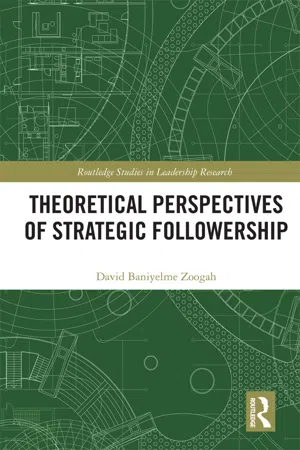Business
Situation Strength Theory
Situation Strength Theory suggests that the impact of personality traits on behavior is dependent on the strength of the situation. In strong situations, where there are clear norms and expectations, personality has less of an impact on behavior, while in weak situations, where there is ambiguity and uncertainty, personality has a greater impact on behavior.
Written by Perlego with AI-assistance
Related key terms
1 Key excerpts on "Situation Strength Theory"
- David Baniyelme Zoogah(Author)
- 2018(Publication Date)
- Routledge(Publisher)
In sum, the strategic contexts—leverage, vulnerability, constraint, and problem—define not only the patterns of relating between firms (Hardy & Phillips, 1998) but also the influence dynamics. According to Fiske (1993) there are communal-sharing, authority-ranking, equality-matching, and market-pricing relationships. Interfirm relationships are characterized by the latter two while interpersonal relationships are characterized by the former two. In these latter two, there is no authority between the firms, but there is collaboration around shared goals and helping one another on the basis of appeals or a loose exchange of favors. In addition to this equality-matching attribute, the relationship may be based around a specific transaction where substantive items are exchanged between the firms. While leverage and vulnerability situations may be associated with equality-matching patterns, constraint and problem situations might be associated with market-pricing relationships. The influence dynamics in equality matching is based on appeals or loose exchanges while that of the market pricing is based on transactions or hard exchanges. The strategic context thus affects the strategic interactions of a following firm and a leading firm. Even though the focus of strategic context here is at the firm level, the components—strategic leverage, strategic constraint, strategic vulnerability, and strategic problem—also apply to individuals. At the interpersonal level, the external and internal relational environments present opportunities, threats, strengths, and weaknesses for individual followers.3.2 Theories of Strategic Situations
3.2.1 Game Theory
The first theory of strategic situations is game theory. Games are basically a taxonomy of strategic situations. Game theory, “the study of mathematical models of conflict and cooperation between intelligent rational decision-makers” (Myerson, 1993: vii–xi), is primarily used in economics, political science, psychology, and management, as well as logic, computer science, and biology. Game theory applies to a wide range of behavioral relations with regard to logical decision-making in humans, animals, and computers. Behavioral game theory specifically focuses on predicting human behavior in strategic situations. Even though there are several types of games, cooperative games seem appropriate in strategic followership. A game is cooperative if a follower and a leader are able to form binding commitments externally enforced (e.g. through contracts). A contract here refers to the social norms implicit in followership and leadership roles. Because analysis of cooperative games focuses on predicting which coalitions will emerge, the joint actions that groups take and the resulting group payoffs, such games seem appropriate for transcendent followership. A game is noncooperative if followers and leaders cannot collaborate or implicit agreements are self-enforcing (e.g. through credible threats). In restorative followership, where the expectations and behaviors of the follower counter those of the leader, cooperation between the leader and follower seems unlikely or impossible. The follower enacts restorative behaviors through self-imposed (e.g., moral) binding commitment. The noncooperative games focus on predicting individual players’ actions and payoffs. So, they seem more appropriate in restorative followership.
Learn about this page
Index pages curate the most relevant extracts from our library of academic textbooks. They’ve been created using an in-house natural language model (NLM), each adding context and meaning to key research topics.
